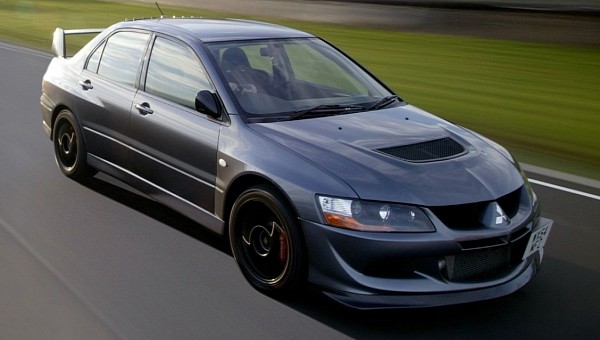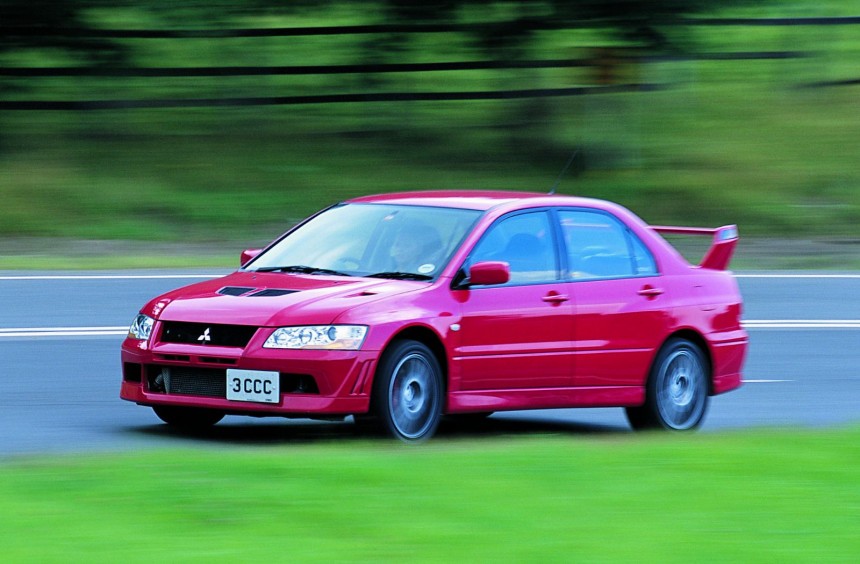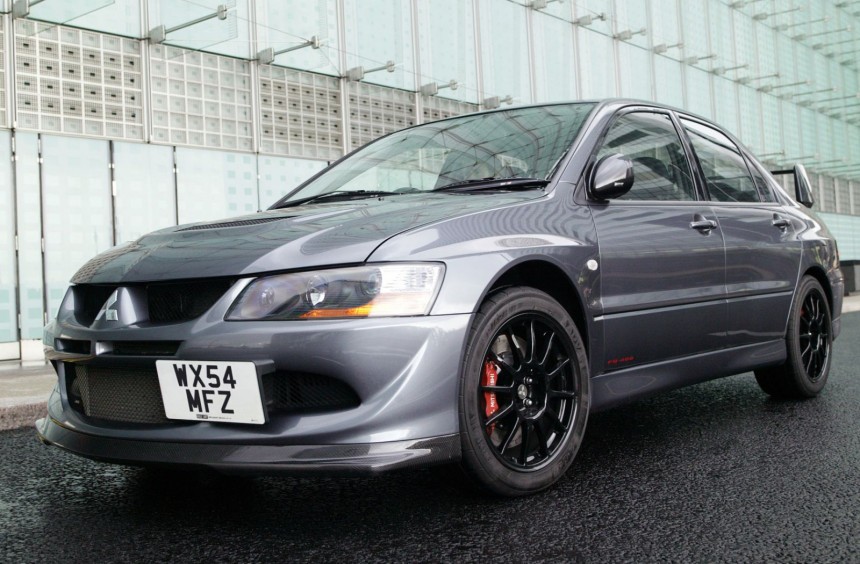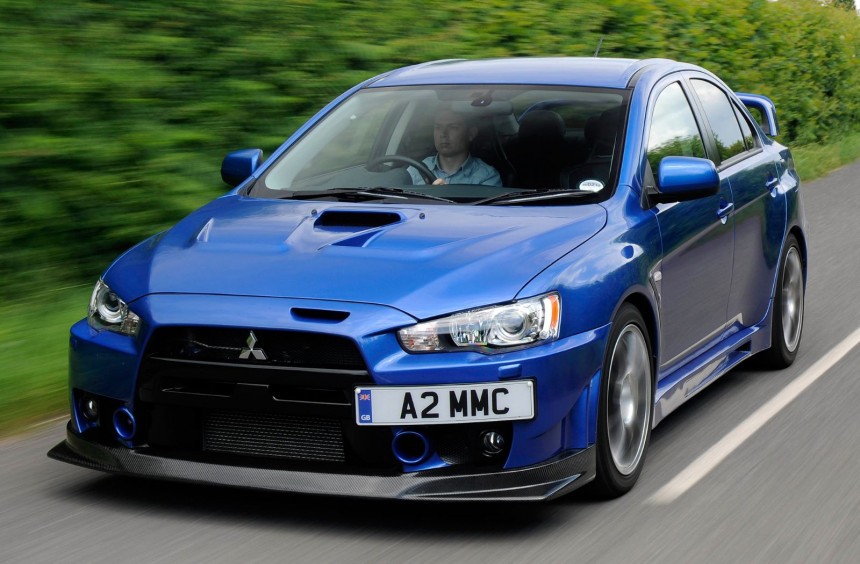Available only in the UK for the eighth and tenth-generation models, the FQ-400 was the quickest, most powerful version of the iconic Lancer Evolution that one could buy from a Mitsubishi dealership.
Introduced in 1992, the first Lancer was conceived to homologate the smaller and nimbler Lancer platform for the World Rally Championship (WRC). A replacement for the Galant VR-4, the Evo borrowed its all-wheel-drive system and its epic turbocharged four-cylinder.
It proved competitive as a rally car, while its street-legal version became very popular fast. Mitsubishi had to build a minimum of 2,500 units to gain homologation. These were sold out in a matter of days, so the carmaker ended up building another 2,500 to meet demand.
The model was continually improved in the years that followed. It morphed into one of the most successful rally cars of the decade, helping the legendary Tommi Mäkinen grab four consecutive WRC drivers’ titles between 1996 and 1999 and giving Mitsubishi its sole manufacturer’s trophy in 1998.
Naturally, the success in the world’s premier rally competition meant a huge boost in terms of sales for the road-going versions. For the first few years, the carmaker only sold the Evolution in Japan, but increasing demand from other markets convinced them to export the rally-bred machine to other parts of the world. So, in 1998, several Evo units were officially exported to Europe.
The UK was quickly emerging as the most important export market for the Evolution. Enthusiasts began realizing the impressive 4G63T four-cylinder was over-engineered and could easily be modified to produce more power.
This led Mitsubishi Ralliart’s UK branch to produce a special, limited edition that would cater to those who wanted to buy an Evo with more power straight from the dealership. Based on the Japanese RS (Rally Sport) version and called RS Sprint, it was a UK-specific Evo VI that shed a little bit of weight and brought a sensible increase over the 276 hp (208 ps) of the JDM-spec model.
With the addition of a modified ECU, ARP Racing conrod bolts, an HKS exhaust system, and a five-speed with shorter gear ratios, the RS Sprint was rated at 330 hp (335 ps). Additionally, they also unleashed the Evo VI eXtreme, a 330-hp (350 ps) monster that featured a blueprinted engine with race-spec crankshaft, conrods, forged pistons, as well as high-lift cams, lightweight valves, and a competition head gasket.
This recipe of Ralliart UK-tuned special editions was carried over to the seventh generation. The eXtreme returned with an output rated at 339 hp (334 ps), but since it was prohibitively expensive, Ralliart UK introduced a new 305-hp (309 ps) special edition dubbed FQ-300 that was cheaper and less extreme, but still f-ing quick – hence the abbreviation.
In 2003, Mitsubishi introduced the eighth iteration of the Evo, which became the first to be marketed on a global stage that included the North American market.
For UK buyers, Ralliart continued to offer a unique series of limited editions that were all part of the FQ range. The entry-level offering was the 301-hp (305 ps) FQ-300, then a couple of mid-range options, dubbed FQ-320 and FQ-330, rated at 326-hp (331 ps) and 330-hp (335 ps) hp, were added. Finally, the range-topping eXtreme was replaced by the FQ-400, which was the most powerful Evo ever sold through a Mitsubishi dealership.
Visually, the 400 came with subtle upgrades that made it difficult to distinguish it from the standard Evo VIII MR it was based on – especially for the untrained eye. These included a carbon fiber lip spoiler, smaller, WRC-style side mirrors, and a carbon “shark teeth” spoiler mounted on the rear window.
The upgrades that made it truly special were found under the hood. Ralliart UK partnered with tuners Owen Developments, Rampage Tuning, and Flow Race Engines, who took the stock 4G63T 2.0-liter engine and turned it into a monster. It received a remapped ECU, forged pistons and conrods, 680-cc injectors, a high-pressure fuel pump, a stainless steel exhaust manifold, and a high-performance catalytic converter. All these goodies enabled the sturdy four-cylinder to spit out 405 hp (411 ps) and no less than 355 lb-ft (481 Nm) of torque.
With all this raw power and a weight of 3,241 pounds (1,470 kg), the FQ-400 entered supercar territory when it came to acceleration. It only took 3.5 seconds to reach 60 mph (97 kph) from a standstill, it could run the quarter mile (402 m) in 12.1 seconds, and when it came to top speed, it could reach 175 mph (282 kph).
This rabid Evo VIII was tested alongside the Murcielago (Lamborghini’s flagship at the time) by BBC’s Top Gear, and the results were surprising, to say the least. As you can see in the videos below, it was just one second slower than the V12-powered mid-engine Lambo.
For the ninth generation, Ralliart UK only offered the FQ-360 based on either the standard Evo or the MR versions, but in 2009, two years after the introduction of the Evo X, the FQ-400 made a comeback.
Like its predecessor, the latest model was equipped with a carbon fiber lip and a “shark teeth” rear window spoiler, but also received a rear diffuser made from the same lightweight material.
Under the hood, the new 4B11T inline-four got the same treatment as its legendary ancestor: a larger, custom Garret turbo, forged internals, high-flow injectors and fuel pump, a custom exhaust manifold, and, of course, a remapped ECU. The heavily-modified engine was rated at 402 hp (408 ps) and 387 lb-ft (525 Nm) of torque, which translated into a 3.8-second sprint to 60 mph (97 kph) and a top speed limited at 155 mph (250 kph).
In terms of sales, the FQ-400 series was not as popular as you would expect. Combined, only around 50 units of both Evo VIII and X FQ-400s were sold, mainly because of its insane price, which made it almost three times more expensive than a standard Evo. This meant that enthusiasts who wanted a f-ing quick Evo could just buy the standard model, spend about 20k on premium mods, and have a car that made more power than the UK special, all while spending less money.
Still, the FQ-400 breed went down in history as the most powerful Evos built by Mitsubishi. That, plus the very low production figures make them extremely sought-after by collectors, and their value is bound to go up in the future.
It proved competitive as a rally car, while its street-legal version became very popular fast. Mitsubishi had to build a minimum of 2,500 units to gain homologation. These were sold out in a matter of days, so the carmaker ended up building another 2,500 to meet demand.
The model was continually improved in the years that followed. It morphed into one of the most successful rally cars of the decade, helping the legendary Tommi Mäkinen grab four consecutive WRC drivers’ titles between 1996 and 1999 and giving Mitsubishi its sole manufacturer’s trophy in 1998.
Naturally, the success in the world’s premier rally competition meant a huge boost in terms of sales for the road-going versions. For the first few years, the carmaker only sold the Evolution in Japan, but increasing demand from other markets convinced them to export the rally-bred machine to other parts of the world. So, in 1998, several Evo units were officially exported to Europe.
The origins of the UK-specific FQ models
This led Mitsubishi Ralliart’s UK branch to produce a special, limited edition that would cater to those who wanted to buy an Evo with more power straight from the dealership. Based on the Japanese RS (Rally Sport) version and called RS Sprint, it was a UK-specific Evo VI that shed a little bit of weight and brought a sensible increase over the 276 hp (208 ps) of the JDM-spec model.
With the addition of a modified ECU, ARP Racing conrod bolts, an HKS exhaust system, and a five-speed with shorter gear ratios, the RS Sprint was rated at 330 hp (335 ps). Additionally, they also unleashed the Evo VI eXtreme, a 330-hp (350 ps) monster that featured a blueprinted engine with race-spec crankshaft, conrods, forged pistons, as well as high-lift cams, lightweight valves, and a competition head gasket.
This recipe of Ralliart UK-tuned special editions was carried over to the seventh generation. The eXtreme returned with an output rated at 339 hp (334 ps), but since it was prohibitively expensive, Ralliart UK introduced a new 305-hp (309 ps) special edition dubbed FQ-300 that was cheaper and less extreme, but still f-ing quick – hence the abbreviation.
The Evo VIII FQ-400
For UK buyers, Ralliart continued to offer a unique series of limited editions that were all part of the FQ range. The entry-level offering was the 301-hp (305 ps) FQ-300, then a couple of mid-range options, dubbed FQ-320 and FQ-330, rated at 326-hp (331 ps) and 330-hp (335 ps) hp, were added. Finally, the range-topping eXtreme was replaced by the FQ-400, which was the most powerful Evo ever sold through a Mitsubishi dealership.
Visually, the 400 came with subtle upgrades that made it difficult to distinguish it from the standard Evo VIII MR it was based on – especially for the untrained eye. These included a carbon fiber lip spoiler, smaller, WRC-style side mirrors, and a carbon “shark teeth” spoiler mounted on the rear window.
The upgrades that made it truly special were found under the hood. Ralliart UK partnered with tuners Owen Developments, Rampage Tuning, and Flow Race Engines, who took the stock 4G63T 2.0-liter engine and turned it into a monster. It received a remapped ECU, forged pistons and conrods, 680-cc injectors, a high-pressure fuel pump, a stainless steel exhaust manifold, and a high-performance catalytic converter. All these goodies enabled the sturdy four-cylinder to spit out 405 hp (411 ps) and no less than 355 lb-ft (481 Nm) of torque.
With all this raw power and a weight of 3,241 pounds (1,470 kg), the FQ-400 entered supercar territory when it came to acceleration. It only took 3.5 seconds to reach 60 mph (97 kph) from a standstill, it could run the quarter mile (402 m) in 12.1 seconds, and when it came to top speed, it could reach 175 mph (282 kph).
This rabid Evo VIII was tested alongside the Murcielago (Lamborghini’s flagship at the time) by BBC’s Top Gear, and the results were surprising, to say the least. As you can see in the videos below, it was just one second slower than the V12-powered mid-engine Lambo.
The Evo X FQ-400
Like its predecessor, the latest model was equipped with a carbon fiber lip and a “shark teeth” rear window spoiler, but also received a rear diffuser made from the same lightweight material.
Under the hood, the new 4B11T inline-four got the same treatment as its legendary ancestor: a larger, custom Garret turbo, forged internals, high-flow injectors and fuel pump, a custom exhaust manifold, and, of course, a remapped ECU. The heavily-modified engine was rated at 402 hp (408 ps) and 387 lb-ft (525 Nm) of torque, which translated into a 3.8-second sprint to 60 mph (97 kph) and a top speed limited at 155 mph (250 kph).
In terms of sales, the FQ-400 series was not as popular as you would expect. Combined, only around 50 units of both Evo VIII and X FQ-400s were sold, mainly because of its insane price, which made it almost three times more expensive than a standard Evo. This meant that enthusiasts who wanted a f-ing quick Evo could just buy the standard model, spend about 20k on premium mods, and have a car that made more power than the UK special, all while spending less money.
Still, the FQ-400 breed went down in history as the most powerful Evos built by Mitsubishi. That, plus the very low production figures make them extremely sought-after by collectors, and their value is bound to go up in the future.



















